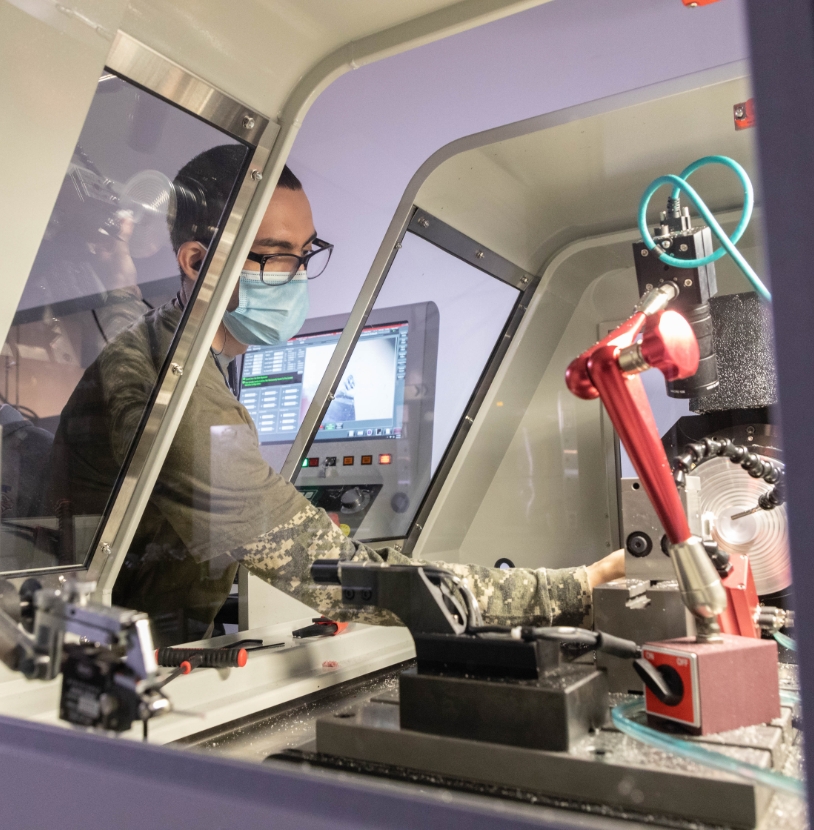The battlefield requires weapons guidance, threat detection, and optical targeting and imaging systems that can be operated in hard-to-distinguish threat environments. In all conditions. Day or night. The need for high precision optics utilizing ultraviolet, visible, and infrared systems technologies is immediate and will continue to accelerate.
Developing cutting-edge optics design and manufacturing technologies along with highly trained technicians and engineers is critical in order to enhance the capabilities of the warfighter. AmeriCOM — the American Center for Optics Manufacturing — is a nationwide initiative to address these needs head-on, significantly building our precision optics industrial base and strengthening the resiliency of its supply chains.
AmeriCOM’s core initiative, the Defense Precision Optics Workforce Development and Technology Ecosystem Project, is funded by the Office of Industrial Policy of the Department of Defense (DoD). Using a consortium model, AmeriCOM will harness the resources of partners in industry, education, nonprofit, and government sectors to expand workforce training programs, undertake new research, expand the precision optics manufacturing base, and secure the nation’s precision optics supply chain.


One of AmeriCOM’s goals is to increase the capacity and quality of skilled optics technicians by a factor of 16 — from less than 50 per year to more than 800 per year by 2025. Doing so will require the successful establishment of technical workforce development capabilities in multiple key locations throughout the U.S., a network of ecosystems that will have a community college at the hub and that will be supported by the regional optics industry cluster plus workforce training and other community-based organizations.
This coordinated effort will grow the number of high schools and two-year colleges teaching precision optics by building optics labs, setting up a curricular clearinghouse, and recruiting and training teachers. A national outreach campaign will be launched to raise awareness of optics as a career path and to recruit students, from a wide range of backgrounds and demographic groups, into apprenticeship and collegiate degree programs.
Optics technicians manufacture optics, perform testing of optics components and systems, and work with scientists and engineers in research, design, development, manufacturing, and quality control
activities. Optics technicians are critical to the companies the United States relies on for defense superiority and national security efforts. The absence of a single technician can delay shipments and impede the productivity of an optics company by causing it to use engineers to perform work that that a trained technician could execute — engineers who would otherwise innovate and create the next generation of precision optics technologies.


Photo source: Lockheed Martin
AmeriCOM is committed to the systematic evaluation of industrial base issues related to precision optics technology development and transition, performance standards development and implementation, and supply chain issues mitigation in order to ensure an optics industrial base responsive to the needs of the U.S. military. The core leadership of the DPOC team is made up of experienced leaders in collaborative research and development (R&D) environments, including people from the original public-private consortium for optics manufacturing, the Center for Optics Manufacturing (COM), a DoD ManTech Center of Excellence from 1989 to 2004.
An advisory and review board made of industry and DoD representatives sets priorities and directs the execution of the AmeriCOM research agenda. The AmeriCOM DPOC team will oversee optics fabrication technology development solicitations, grant R&D projects, publish technical efforts, and catalyze commercialization for new, mission-critical technologies. A new research and training facility will be established where challenges such as hypersonic optics and directed energy systems as well as manufacturing and design challenges related to extreme performance systems, specialty materials, difficult geometries, and thin film coatings (and more) will be studied.
